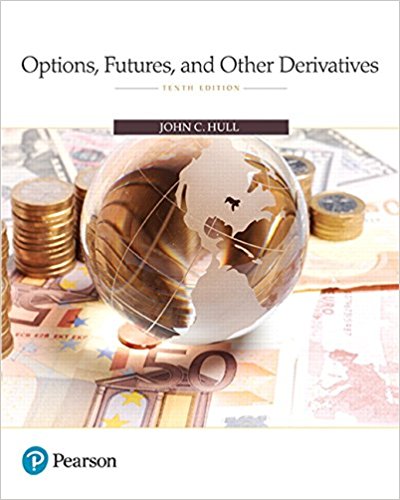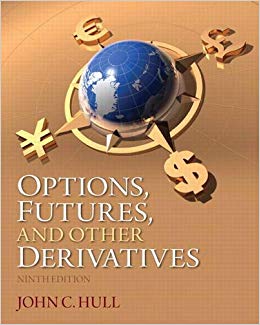Options Futures and Other Derivatives 10th Edition By JohnC. – Test Bank
Hull: Options, Futures and Other Derivatives, Tenth Edition
Chapter 4: Interest Rates
Multiple Choice Test Bank: Questions with Answers
- The compounding frequency for an interest rate defines
- The frequency with which interest is paid
- A unit of measurement for the interest rate
- The relationship between the annual interest rate and the monthly interest rate
- None of the above
Answer: B
The compounding frequency is a unit of measurement. The frequency with which interest is paid may be different from the compounding frequency used for quoting the rate.
- An interest rate is 6% per annum with annual compounding. What is the equivalent rate with continuous compounding?
- 5.79%
- 6.21%
- 5.83%
- 6.18%
Answer: C
The equivalent rate with continuous compounding is ln(1.06) = 0.0583 or 5.83%.
- An interest rate is 5% per annum with continuous compounding. What is the equivalent rate with semiannual compounding?
- 5.06%
- 5.03%
- 4.97%
- 4.94%
Answer: A
The equivalent rate with semiannual compounding is 2×(e0.05/2−1) = 0.0506 or 5.06%.
- An interest rate is 12% per annum with semiannual compounding. What is the equivalent rate with quarterly compounding?
- 11.83%
- 11.66%
- 11.77%
- 11.92%
Answer: A
The equivalent rate per quarter is . The annualized rate with quarterly compounding is four times this or 11.83%.
- The two-year zero rate is 6% and the three year zero rate is 6.5%. What is the forward rate for the third year? All rates are continuously compounded.
- 6.75%
- 7.0%
- 7.25%
- 7.5%
Answer: D
The forward rate for the third year is (3×0.065−2×0.06)/(3−2) = 0.075 or 7.5%.
- The six-month zero rate is 8% per annum with semiannual compounding. The price of a one-year bond that provides a coupon of 6% per annum semiannually is 97. What is the one-year continuously compounded zero rate?
- 8.02%
- 8.52%
- 9.02%
- 9.52%
Answer: C
If the rate is R we must have
or
so that R = ln(1/0.9137) = 0.0902 or 9.02%.
- The yield curve is flat at 6% per annum. What is the value of an FRA where the holder receives interest at the rate of 8% per annum for a six-month period on a principal of $1,000 starting in two years? All rates are compounded semiannually.
- $9.12
- $9.02
- $8.88
- $8.63
Answer: D
The value of the FRA is the value of receiving an extra 0.5×(0.08−0.06)×1000 = $10 in 2.5 years. This is 10/(1.035) = $8.63.
- Under liquidity preference theory, which of the following is always true?
- The forward rate is higher than the spot rate when both have the same maturity.
- Forward rates are unbiased predictors of expected future spot rates.
- The spot rate for a certain maturity is higher than the par yield for that maturity.
- Forward rates are higher than expected future spot rates.
Answer: D
Liquidity preference theory argues that individuals like their borrowings to have a long maturity and their deposits to have a short maturity. To induce people to lend for long periods forward rates are raised relative to what expected future short rates would predict.
- The zero curve is upward-sloping. Define X as the 1-year par yield, Y as the 1-year zero rate and Z as the forward rate for the period between 1 and 1.5 years. Which of the following is true?
- X is less than Y which is less than Z
- Y is less than X which is less than Z
- X is less than Z which is less than Y
- Z is less than Y which is less than X
Answer: A
When the zero curve is upward-sloping, the one-year zero rate is higher than the one-year par yield and the forward rate corresponding to the period between 1.0 and 1.5 years is higher than the one-year zero rate. The correct answer is therefore A.
- Which of the following is true of the Fed funds rate
- It is the same as the Treasury rate
- It is an overnight interbank rate
- It is a rate for which collateral is posted
- It is a type of repo rate
Answer: B
At the end of each day, some banks have surplus reserves on deposit with the Federal Reserve others have deficits. They use overnight borrowing and lending at what is termed the Fed funds rate to rectify this.
- The modified duration of a bond portfolio worth $1 million is 5 years. By approximately how much does the value of the portfolio change if all yields increase by 5 basis points?
- Increase of $2,500
- Decrease of $2,500
- Increase of $25,000
- Decrease of $25,000
Answer: B
When yields increase bond prices decrease. The proportional decrease is the modified duration times the yield increase. In this case, it is 5×0.0005=0.0025. The decrease is therefore 0.0025×1,000,000 or $2,500.














Reviews
There are no reviews yet.